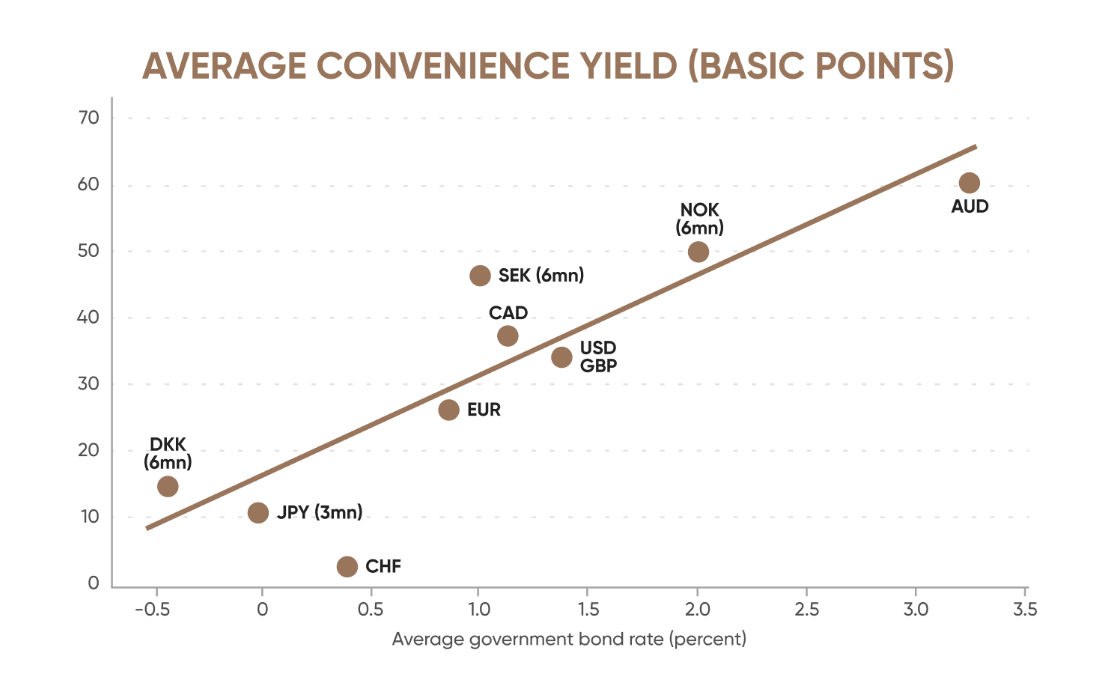What is convenience yield and how does it work?

Many market participants value holding a physical commodity more than a mere promise of future delivery. The additional benefit of immediate possession – such as securing supply, avoiding shortages or maintaining operational flexibility – differs from holding a claim on future delivery. Convenience yield quantifies these benefits and is incorporated into the cost-of-carry model to explain discrepancies between futures and spot prices, helping traders assess implied supply pressures and the value of storage.
Key takeaways
-
Convenience yield represents the non-monetary benefit of holding physical commodities rather than futures contracts, quantifying advantages like securing supply, avoiding stock-outs, and maintaining operational flexibility against delivery delays or shortages.
-
The cost-of-carry model shows futures prices equal spot price plus carry costs minus convenience yield; high yield causes backwardation (spot exceeds futures, indicating scarcity) while low yield creates contango (futures exceed spot, the typical condition).
-
Traders use convenience yield as a key signal of market pressure: high yield suggests tight near-term supply while low yield indicates ample inventories, allowing traders to anticipate supply-demand shifts and adjust positions accordingly.
-
Convenience yield cannot be directly observed and must be inferred from price differences, requiring accurate estimates of storage costs and risk-free rates; errors in these inputs can significantly distort the calculated yield.
-
Key factors influencing convenience yield include inventory levels, price volatility, seasonal demand patterns (such as heating oil in winter), and unforeseen events like geopolitical risks, extreme weather, or technical failures that trigger temporary spikes.
What is convenience yield?
Convenience yield is an implied benefit. It is the non-monetary value of holding a physical commodity. These include ensuring supply, avoiding stock-outs and maintaining operational flexibility. It is an implicit return on holding inventory rather than cash. Since holders have immediate access to the commodity, they avoid delivery delays or shortages. This yield is crucial in futures contract pricing: it offsets storage and financing costs in the cost-of-carry framework, explaining discrepancies between spot and futures prices.
This concept stems from the theory of storage. This theory connects the spot price of a commodity to its future price. In the cost-of-carry equation, net carrying cost equals storage and financing costs minus convenience yield. The cost of carry includes storage and financing costs. It helps explain when a futures price is lower than the spot price. This situation is called backwardation.
Why does convenience yield exist?
Convenience yield exists primarily because of the risk of supply shortages. If a company needs a commodity to run its factory, a shortage is a serious problem. This is called a stock-out. A stock-out forces operations to halt, which can be disruptive and costly.
Holding inventory acts as insurance against this risk. If a sudden supply disruption occurs, the company with stock on hand can continue operating. The value of uninterrupted production is the convenience yield. This benefit increases when supply is tight or demand is seasonal, and decreases when inventories are ample.
Pat performance is not a reliable indicator of future results.
Explore this concept in practice by opening a demo account – gain experience of how convenience yield works in commodities trading without risking real funds.

How convenience yield works
Convenience yield directly affects the relationship between futures and spot prices. Spot price is the price for immediate delivery, while the futures price is the price for delivery at a future date.
The relationship is shown through the cost-of-carry model. This model states that the futures price should generally equal the spot price plus the cost of carry. The cost of carry comprises storage, financing and insurance costs. But the convenience yield is a benefit to the spot holder. Therefore, it is subtracted from the calculation.
In simple terms:
If the convenience yield is low, the cost of carry prevails. The futures price is higher than the spot price. This market state is called contango and is the typical market condition.
If the convenience yield is high, it outweighs the cost of carry. The spot price is higher than the futures price. This market state is called backwardation, which may indicate current scarcity where market participants pay a premium for immediate supply.
Role of storage costs and supply constraints
Storage costs are the direct expenses incurred in holding a commodity. They include warehouse rent, security and insurance. These costs increase the cost of carry, making futures prices generally higher than spot prices when the convenience yield is low.
Supply constraints drive convenience yield. When inventories are limited, the risk of a stock-out rises, enhancing the value of immediate access. High convenience yield can offset storage costs. For example, if a hurricane halts oil production, supply is constrained and the premium for holding oil now increases sharply, pushing the market into backwardation. Conversely, when storage capacity is ample and inventories are plentiful, convenience yield falls toward zero, reflecting reduced benefit from additional stock.
Potential benefits and risks of convenience yield
Traders and investors must understand what convenience yield is because it is a key signal of short-term market pressure.
A high convenience yield (backwardation) suggests that immediate demand outstrips available supply. Traders may view this as an indication of tight near-term supply rather than a durable price peak.
A low convenience yield (contango) indicates that inventories are ample and carry costs dominate, reflecting a more relaxed market. By monitoring implied convenience yield over time, traders can anticipate shifts in supply and demand. For example, a sudden increase in yield may indicate a looming shortage, allowing traders to adjust positions accordingly.
However, convenience yield is not directly observable; it must be inferred. Estimating storage costs and the risk-free rate accurately is essential, and errors in these inputs can distort the calculated yield.
Several factors can markedly influence convenience yield, including:
- Inventory levels: low stock raises convenience yield.
- Price volatility: greater uncertainty enhances the value of on-hand supply.
- Seasonal demand: commodities like heating oil often see higher yield in winter months.
- Unforeseen events: geopolitical events, extreme weather or technical failures can trigger sharp, temporary spikes in convenience yield.
Past performance is not a reliable indicator of future results.
Real-world example of convenience yield
Crude oil illustrates convenience yield in practice. Refineries require oil to operate, so when supply is tight, immediate availability carries significant value, preventing costly shutdowns. In periods of expected shortfall – for example, when demand growth outpaces production capacity or geopolitical risks threaten shipments – convenience yield rises sharply.
The reverse occurred during the 2020 pandemic. Oil demand collapsed while inventories surged, leaving few additional benefits from extra stock. Storage costs dominated, and the market moved into deep contango as convenience yield fell to near zero or below.
Pat performance is not a reliable indicator of future results.
Explore how convenience yield impacts pricing in live markets by opening a demo or live account.
FAQs
What is convenience yield in commodities trading?
Convenience yield is the implied premium associated with holding a physical commodity. This value arises from the ability to use or deliver the asset immediately and serves as insurance against supply shortages.
How do you calculate convenience yield?
You can infer convenience yield using the cost-of-carry model. The annualised yield, ‘y’, is calculated as:
y = r + s − [ln(F/S) ÷ t]
Here, r is the annualised risk-free interest rate, s is the annualised storage cost, F is the futures price, S is the spot price, t is the time to maturity (in years), and ln denotes the natural logarithm.
Why is convenience yield important for futures contracts?
Convenience yield is a vital component of the futures-pricing relationship. When it exceeds the combined financing and storage costs, futures prices trade below spot (backwardation). It captures the non-monetary, operational benefit that physical holdings provide beyond what a futures contract can offer.
What are the risks associated with convenience yield?
The main risks stem from its indirect estimation: convenience yield must be inferred rather than observed, so inaccuracies in storage-cost or interest-rate inputs can distort results. Additionally, it is highly sensitive to sudden supply shocks, which can increase commodity price volatility. Traders should continually monitor inventory levels, market disruptions and seasonal factors to manage these risks.
What is the Edison IPO?
It’s the proposed initial public offering of Edison S.p.A., the Italian energy company owned by EDF, which is considering returning the business to public markets.